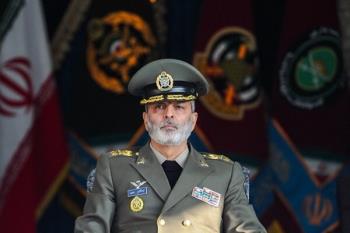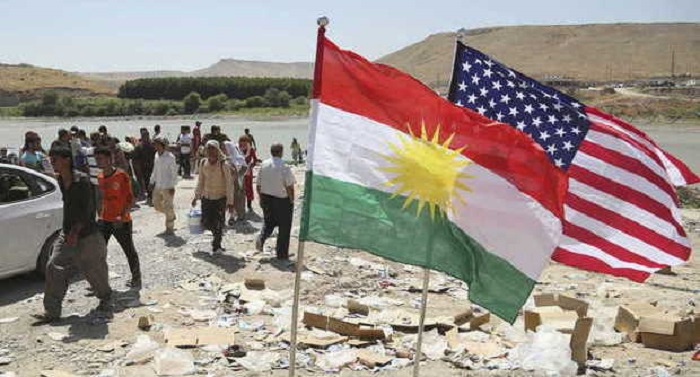Alwaght- As the countdown for liberation of Iraq’s ISIS-held Mosul starts, the news spread that the United States has decided to open a safe passage for the ISIS terrorists and leaders to leave the Iraqi northern city for eastern Syria, in particular Deir ez-Zour province, through a border crossing close to Al-Bukamal town in Deir ez-Zour.
Russia’s Sputnik news agency has told of the joint US-Saudi decision to allow the Mosul-based terrorists to move to Syria. The news agency added that the preparations for safe exit of the armed groups from the Iraqi city have been made even before the Mosul recapture operation officially started.
Additionally, Washington and Riyadh have reportedly agreed that ISIS' top elements along with their families to be transferred from Mosul to Syria's Deir ez-Zour before the Iraqi forces' major assault through a safe gate that will be opened for them. The two agreed that the US-led military coalition’s fighter jets bomb only some buildings that before offensive were evacuated according to terms of a deal with the terrorists.
Earlier, the Iraqi Defense Minister Khaled al-Obeidi had said that some of the leaders of ISIS fled Mosul to the Syrian territory along with their families. Recently, local media circulated news updates about escape of 50 ISIS leaders' families of Saudi nationality from Mosul to Syria’s Deir ez-Zour. The fled ISIS elements were said to have taken residence in the three villages of Al-Qabra, Al-Abbass, and Al-Hasrat between a road that connects Al-Mayadin and Al-Bukamal towns in eastern Deir ez-Zour outskirts. The families, “according to the trusted sources”, were close to ISIS' leader Abu Bakr al-Baghdadi.
Stationing these terrorist elements in Deir ez-Zour outskirts strengthens to a large extent a leaked scenario for stationing the escaped leaders of the ISIS in Syria’s east, especially in Deir ez-Zour, and empowering the terrorist group in this Syrian province.
According to the available information, more than 9,000 ISIS militants are now in Mosul. Once a large part of these forces are transferred to the eastern Syria, a very special capability will be created for the terrorist group to attack the Syrian army’s forces which are now surrounded in some Deir ez-Zour areas including the Airport District as well as Jabal Al-Tharda, and so the way will be paved for full fall of the province.
But these terrorist forces will not only be moved to the eastern regions. They will go also to Hama eastern outskirts, Aleppo southern outskirts, and Qalamoun's east to open new fronts and shift to an erosive battle to enfeeble the Syrian army, especially that in the current conditions the Syrian military has the upper hand in the battleground in Aleppo and other frontlines.
It seems that the US eyes short and long-term aims behind relocating ISIS from Mosul to the eastern and other fronts in Syria. There are a couple of points on this transfer, provided that the grounds are made for removal of ISIS from Mosul to Syria’s east.
The short-term objectives of Washington for relocating the terrorists from Iraq to Syria include engaging the Syrian forces and their allies in Deir ez-Zour and opening a new battlefield in this province for the final aim of making the battle an erosive process. The US wants the terror crisis in eastern Syria to remain a dynamic and active situation, especially that a the Jabhat Fateh al-Sham, the former al-Nusra Front, is now under a tough encirclement imposed by the Syrian army in Aleppo, and as the encirclement continues, the Syrian government’s forces get further chances to advance to the heart of Aleppo and the city’s outskirts particularly the northern outskirt. Once Aleppo is liberated from the terrorists, other fronts like Idlib will be very vulnerable and prone to fall to army. This in turn will scale down the security crisis raised by the militants. Therefore, by moving the terrorists to eastern front and other fronts Washington wants to manage the clashes and keep instability and insecurity still an active situation. An active state of insecurity will allow the conditions ready for the military and security interventions of the US and its allies.
The US attempts to facilitate ISIS' full capture of Deir ez-Zour province are not a fresh matter. Earlier, Washington carried out airstrikes on the positions of the Syrian armed forces in Deir ez-Zour in a bid to prepare the ground for seizing control of the province, particularly the Airport District, by the terrorists. But its project was met with failure so far. The anti-Syrian airstrikes in Deir ez-Zour came with the aim of backing the terrorists in the battlefield and empowering them to press ahead and seize control of the Airport District and Jabal Al-Tharda strategic area to complete Deir ez-Zour blockage. Jabal Al-Tharda is geopolitically a high region and overlooks Deir ez-Zour airport. Controlling the region by ISIS will mean fall of the Airport District and even the whole of Deir ez-Zour province.
But this plan had drawn strong Russian outcry and led to intensification of the differences between the two countries on Syria conflict to a point that the Russian officials sought taking escalatory measures to respond to US's plot. Russians also have taken preemptive measures like deploying additional S-300 and other air defense systems to Syria to make sure that they will bar Washington from launching air raids in the future.
Accordingly, in the present conditions, the US intends to intensify ISIS' presence and activity in Deir ez-Zour to highlight and magnify ISIS threat in this province and keep the situation prepared for military and air intervention in Syria on the one hand and steer clear of entry in direct fight with the Syrian forces by its fighter jets or by the allied players on the ground like the Kurds before full capture of Deir ez-Zour by ISIS on the other hand. Actually Washington does not want to face a reaction from Damascus' regional and international allies.
Washington’s long-term intention from pushing ISIS into Syria’s east is to allow full control of the province by the US' trusted allies, the Kurdish forces represented by Syrian Democratic Forces (SDF or QSD as Kurdish acronym). To this end, the US should give the Kurds air cover. All these plans are implemented only when ISIS takes full control of Deir ez-Zour. By this plan the US on the one hand will paint itself as an anti-terror force in Syria and on the other hand will tip the scales of power in its favor. In fact, it seeks gaining appropriate instruments and pressure tools to wrest concessions from the opposite side in post-military time of the Syrian crisis. The Kurdish capturing of Deir ez-Zour to some degree will change the balance of power in favor of the US and its allies in Syria. This allows Washington to invest in this trump card for the political stage and negotiating table in the future.
In the past, the New Syrian Army (NSA) which is recognized as a US-developed force in Jordan, moved to eastern outskirts of Deir ez-Zour to take on ISIS while it is backed by the American air cover. It managed to make partial advances and captured Hamdan village and its military airport. But this victory did not last longer than a couple of hours, and the US-backed force retreated after receiving a heavy blow from ISIS. This loss foiled the US project of training allied forces to fight on the ground. The NSA is now stationed in Al-Tanf border crossing between Syria and Iraq.
We need to wait to see if the US with the help of the Kurdish forces can capture Deir ez-Zour province. This, in turn, will require ISIS' success in its new mission which is putting pressures on the Syrian forces and pushing them back. This will allow the US and allies to justify presence in Syria by their anti-ISIS campaign.



























